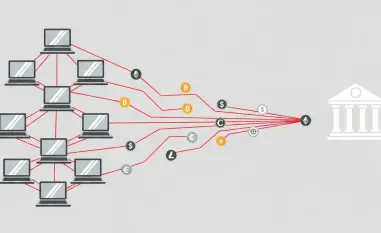Ransomware attacks have become a significant concern for governments and organizations worldwide. The United Kingdom, recognizing the growing threat, has initiated legislative proposals aimed at mitigating the impact of ransomware. This article explores these proposals, their potential effectiveness, and the broader implications for cybersecurity in the UK.
Understanding Ransomware
Defining Ransomware
Ransomware is a type of malicious software that infects computer systems, preventing access to data or stealing it. The attackers then demand a ransom, usually in cryptocurrency, to restore access or refrain from publicizing stolen data. This definition aligns with those used by major industry bodies like ISO, ENISA, and NIST. The intricate nature of ransomware attacks, which can cause operational halts and significant financial losses, makes them one of the most feared forms of cybercrime today.
The global landscape of cyberattacks emphasizes an urgent need for comprehensive understanding and robust preventive measures. Attackers leverage sophisticated methods to infiltrate systems, often targeting vulnerabilities in security protocols. The anonymity provided by cryptocurrency complicates the process of tracing and apprehending these criminals. Hence, the sheer complexity and evolving nature of ransomware necessitate a multifaceted approach to combating it effectively.
The Growing Threat in the UK
Ransomware attacks have become increasingly prominent, with high-profile incidents like the WannaCry attack in 2017 highlighting their impact. The WannaCry attack affected approximately 230,000 computers across 150 countries within hours, encrypting files and demanding Bitcoin payments to restore access. This incident alone underscored the devastating potential of ransomware, prompting governments worldwide to reassess their cybersecurity strategies.
The UK’s National Cyber Security Centre (NCSC) and the National Crime Agency (NCA) have identified ransomware as the most significant cybercrime threat, with substantial implications for Critical National Infrastructure (CNI) and national security. The frequency of ransomware attacks reported to the Information Commissioner’s Office (ICO) has reached unprecedented levels since 2019, with a marked increase in victims from 2022 onward. Stemming the tide of these attacks is crucial for safeguarding national assets and protecting public interests.
Legislative Proposals
Proposal 1: Ban on Ransomware Payments by Public Sector and CNI Owners/Operators
This proposal aims to prohibit all UK public sector bodies and the owners and operators of Critical National Infrastructure (CNI) from making ransomware payments. The ban extends the current directive for central government departments to a broader range of public sector entities and critical national assets, including essential services like energy, water, transportation, health, and telecoms. The rationale behind this proposal is to reduce the flow of money to cybercriminals, thereby decreasing the incentive for such attacks.
Despite the apparent benefits, the proposal does not address potential downstream effects on other economic operators not subject to the ban. There is a risk that attackers may shift their focus to entities outside the ban’s scope, increasing threats to individuals and small businesses. The responses to the consultation may provide insights into these broader impacts. This measure needs to consider the ripple effects across various sectors and ensure that vulnerabilities are not simply transferred to less protected areas.
Potential Impacts and Concerns
The consultation document fails to fully address the potential downstream or collateral effects of this prohibition on other economic operators who are not covered by the ban. For instance, while public sector entities and CNI hold vast amounts of sensitive data, other organizations also face substantial risks from ransomware attacks. There is a possibility that attackers could redirect their efforts toward these unprotected sectors, exacerbating threats to individuals and small businesses.
The consultation responses may help clarify these points and provide insights into the potential broader impacts. Additionally, there are concerns that the prohibition might lead to unintended consequences, such as increasing the leverage of attackers on victims who fall outside the ban’s scope. Understanding these dynamics is crucial for developing a comprehensive approach that effectively mitigates ransomware threats without inadvertently creating new vulnerabilities in the cybersecurity landscape.
Proposal 2: Ransomware Payment Prevention Regime
Under this proposal, organizations and individuals not covered by the Proposal 1 ban must notify authorities of their intent to make a ransomware payment within 72 hours of the ransom demand. A full report must then be submitted within 28 days. Authorities will review the notification to decide if the payment should be blocked, especially if it contravenes sanctions or terrorism finance legislation. This measure aims to introduce oversight and control over ransomware payments.
The proposal endeavors to establish a framework for better regulation and oversight, ensuring that payments do not inadvertently fund illegal activities. However, the complexities of dealing with ransomware victims must be acknowledged. Critics may argue against penalizing victims who disobey directives, especially when the actual attackers evade legal consequences. The responsiveness and regulation against potential ransom payments could pose difficulties, given that attackers are often difficult to identify or apprehend.
Challenges and Criticisms
This proposal acknowledges the complexities of dealing with ransomware victims. For instance, the immediate stress and urgency faced by organizations during a ransomware attack can hinder their willingness or ability to comply with stringent reporting requirements. Critics may argue against penalizing victims who disobey directives while the actual attackers evade legal consequences. The concept of penalizing victims when the true culprits remain at large sparks significant debate among cybersecurity experts.
Moreover, the effectiveness of the measure may be undercut by the difficulty of tracing and apprehending anonymous attackers. The proposal must balance incentivizing compliance with recognizing the burdens placed on victims. This delicate balance highlights the need for a comprehensive, considerate approach that both mitigates threats and supports victims rather than adding to their challenges during already tumultuous circumstances.
Proposal 3: Ransomware Incident Reporting Regime
The third proposal calls for a mandatory incident reporting regime wherein suspected ransomware victims must inform authorities about an incident, regardless of their intention to pay the ransom. The Home Office is considering whether this requirement should apply universally across the economy or only to those meeting a specific threshold, such as when the ransom demanded exceeds a certain monetary value. This proposal aims to enhance intelligence gathering and response capabilities.
Mandatory reporting would ensure better data collection, aiding in the development of more effective countermeasures. Comprehensive incident reports could highlight emerging trends and vulnerabilities, guiding future cybersecurity policies. However, the proposal must balance the benefits of mandatory reporting with the administrative burden it places on organizations. The establishment of clear reporting criteria and thresholds is essential to streamline this process and prevent overwhelming businesses with excessive regulatory demands.
Overlapping Legislation
Organizations affected by these proposals already have reporting obligations under existing regulations, such as the UK’s General Data Protection Regulation (GDPR), the Network and Information Systems Regulations 2018, and the Privacy and Electronic Communications Regulations. There is some uncertainty about how these new proposals would interact with the existing framework. The introduction of additional reporting requirements could create redundancies or conflicts, complicating compliance efforts for affected organizations.
To ensure coherence and effectiveness, it is crucial to harmonize these new measures with existing regulations. This involves a detailed assessment of current reporting obligations and identifying overlaps and gaps. Effective integration will require collaboration between regulatory bodies, industry stakeholders, and the public, ensuring that the new proposals complement rather than conflict with the established legislative landscape.
Broader Implications for Cybersecurity
Reducing the Flow of Money to Ransomware Criminals
The proposals aim to reduce the flow of money to ransomware criminals, thereby decreasing the attractiveness of these targets for attackers. By preventing payments from public sector entities and critical infrastructure organizations, the UK hopes to reduce the overall incidence of ransomware attacks. This approach aligns with the broader objective of disrupting the financial incentives that drive such criminal activities.
However, the effectiveness of this strategy hinges on its implementation and enforcement. Ensuring that the ban is comprehensive and well-monitored is essential to truly deter ransomware attacks. The proposals must also consider potential loopholes and strategies that attackers might employ to bypass the newly imposed restrictions. A thorough understanding of ransomware tactics and the continuous evolution of cyber threats is necessary to stay ahead of this persistent menace.
Boosting Intelligence and Investigation Efforts
The proposals also aim to boost intelligence around ransomware payments to aid disruption and investigation efforts. Improved reporting and notification requirements can enhance the UK Government’s understanding of ransomware threats and support more effective responses. By gathering detailed information on incidents and payments, authorities can develop better strategies for prevention and recovery.
Enhanced intelligence efforts can lead to more targeted cybersecurity measures, disrupting ransomware operations at their core. Collaboration with international allies and security experts can further strengthen these endeavors, leveraging collective knowledge and resources to combat global ransomware threats. Sharing insights and best practices across borders is crucial, as cyber threats often transcend national boundaries.
Collaboration and Integration with Existing Frameworks
Collaboration between existing frameworks and the proposed new regime will be vital to ensure the coherent integration of these measures. The consultations aim to gather feedback from industry experts, policymakers, and the public to refine the proposed legislation. Input from a diverse range of stakeholders will help shape effective and practical measures that can be seamlessly implemented.
Further insights from industry stakeholders and the public will help shape these proposals into effective legislative tools against ransomware threats. The collective expertise will aid in identifying potential gaps and ensuring that the new measures are both comprehensive and executable. Effective collaboration will enable the UK to build a robust framework that addresses the evolving challenges of cybersecurity in a dynamic technological landscape.
Conclusion and Next Steps
Ransomware attacks have escalated, becoming a critical issue for governments and organizations across the globe. In response to this escalating threat, the United Kingdom has taken proactive steps by introducing legislative proposals designed to lessen the impact of ransomware. These new legal initiatives aim to both prevent attacks and mitigate their consequences, reflecting a deep understanding of the urgent need for stronger cybersecurity measures.
This article delves into the specifics of these legislative proposals, examining their potential effectiveness in combating ransomware attacks. In addition to exploring the details of the new laws, it also addresses the broader implications for cybersecurity within the UK. By implementing these proposals, the UK government hopes to not only safeguard its own systems but also set a precedent for other nations grappling with similar cybersecurity challenges. The comprehensive approach taken by the UK underscores the importance of coordinated efforts and robust legal frameworks in the global fight against ransomware.













